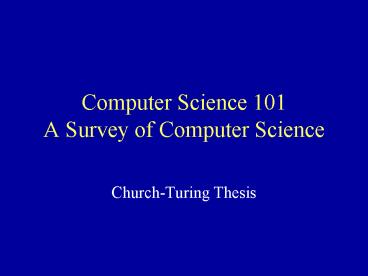Computer Science 101 A Survey of Computer Science - PowerPoint PPT Presentation
1 / 17
Title:
Computer Science 101 A Survey of Computer Science
Description:
... Science 101. A Survey of Computer Science ... With more time, we could do much more impressive things. So far, we have used a new machine for each problem. ... – PowerPoint PPT presentation
Number of Views:36
Avg rating:3.0/5.0
Title: Computer Science 101 A Survey of Computer Science
1
Computer Science 101A Survey of Computer Science
- Church-Turing Thesis
2
Where we are
- We have looked at the definition of Turing
machines simple models of computing agents. - We have seen a series of examples showing that we
can do numerical algorithms, rearranging, etc. - We have seen how we can piece together machines
for simple problems to solve more complex
problems. - With more time, we could do much more impressive
things. - So far, we have used a new machine for each
problem. Now we look at the notion of a
programmable Turing machine.
3
Encoding a Turing Machine
- To encode symbols of the alphabet Use 1 for
b Use 11 for second symbol Use 111 for third
symbol, etc. - To encode states Use 1 for first state Use
11 for second state, etc. - To encode directions Use 1 for L Use 11 for R
4
Encoding a Turing Machine (cont.)
- To encode instructions Encode the components of
the instructions and separate by 0s. - Example Suppose alphabet is b,0,1 so b is
encoded as 1, 0 as 11, 1 as 111.Then the
instruction (3,1,0,2,L) would be encoded as
111011101101101. - To encode a Turing machine Encode the
instructions and separate by 0s.
5
Encoded TM
- Here is the code (serial number) for a Turing
Machine with alphabet b,1 1011011010101010110
1101or Turing Machine number 5985645
6
Universal Turing Machine
- A Universal Turing Machine, U
- U is a Turing Machine
- U takes as input
- The encoding of another TM, M, (this is the
program) and - Some string S of input symbols for M
- U produces as output
- Whatever output M would have produced if it had
been given input S
7
Universal Turing Machine (cont.)
- So a universal Turing machine is programmable in
that you can program it with the encoding of
another machine and it will simulate that machine
(program). - The details of how U works are beyond the scope,
but basically - It keeps sections of its tape
- For the current state of M
- A copy of what Ms tape would look like
- It scans to see what state M would be in, what it
would be reading. Then it finds an instruction
that matches. It then carries out the actions
that M would do.
8
Church Turing Thesis
- Church-Turing Thesis If there is an algorithm to
do a symbol manipulation task, then there is a
Turing machine to do that task. - Or, contrapositively If such a task can not be
done with a Turing machine, then there is no
algorithm to do the task.
9
Church Turing Thesis (cont.)
- The Church-Turing Thesis is not a theorem to be
proven, but an accepted theoretical definition of
a computation or algorithm. - Why is Church-Turing Thesis accepted?
- Every algorithm presented was shown to be
solvable by TM - Other very different attempts (by very smart
people) to define computability were shown to be
equivalent to TMs
10
Proof by Contradiction
- Proof by contradiction is an important proof
technique used by mathematicians and logicians. - To prove statement P true
- Make the assumption that P is false
- Show that this leads to a logical contradiction
- Conclude that the assumption must be false i.e.,
that P must be true.
11
The Halting Problem
- The problem Find TM (algorithm), H, that takes
as input - Encoding, M of a TM (program), M, and
- Input for M (input for the program), S
- and outputs
- 1 if M will eventually halt on input S
- 0 if M will not halt on input S
- Note such an algorithm would let us know whether
or not it is safe to execute the program on the
given input.
12
Halting Problem (cont.)
- Suppose we have TM, H, as proposed
M b S
H
Halts with 1 on tape if M halts with input S
Halts with 0 on tape if Mnever halts with input S
13
Halting Problem (cont.)
- Modify H by adding instructions to cause it to
loop forever once it reaches the halt with 1
configuration.
14
Halting Problem (cont.)
- Modify K by having it first make copy of its
input and then simulate K
15
Halting Problem (cont.)
- Now suppose we give Q its own encoding for input
16
Halting Problem (cont.)
- So
- Q never halts on input Q if Q halts on input Q
- Q halts on input Q if Q never halts on input Q
- This is a contradiction
- Suppose we have TM, H, as proposed
- Conclusion No such H exists Halting problem is
unsolvable by algorithm
17
Unsolvable Problems
- Problems for which no algorithm can exist (1000s
known) - Decide whether Java program will terminate on
given input. - Decide whether two Java programs will always give
the same output. - Decide whether a given polynomial has roots that
are whole numbers. - Decide whether a given TM will halt if given a
blank tape































